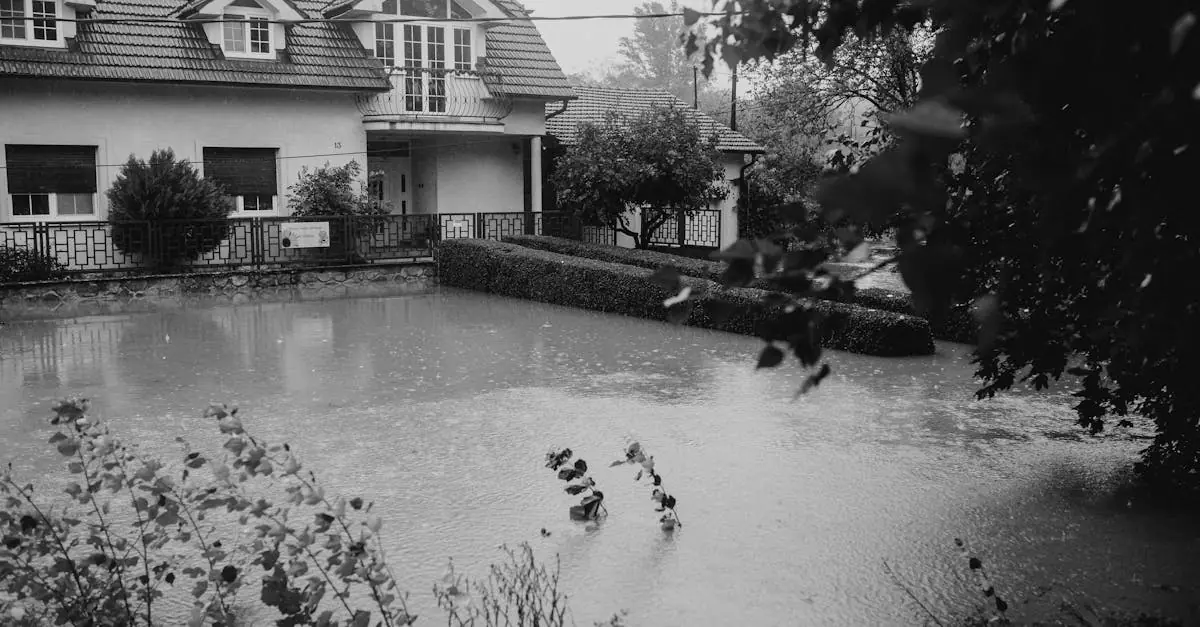Table of Contents
ToggleHomeownership brings a sense of pride and accomplishment, but it also comes with its fair share of headaches. One minute you’re enjoying a sunny afternoon on your porch, and the next, you’re dealing with a tree that decided to make your roof its new home. So, does homeowners insurance cover structural damage? It’s a question that every homeowner should have on the tip of their tongue, ready to roll off like a well-rehearsed punchline.
Understanding Homeowners Insurance
Homeowners insurance protects against various risks associated with property ownership. It typically covers structural damage resulting from hazards like fire, theft, or windstorms. Policies often include dwelling protection, which refers specifically to the home’s structure.
Many homeowners don’t realize that standard policies may exclude certain types of damage, such as that caused by flooding or earthquakes. Additional coverage options are available for these specific risks. Reviewing policy exclusions helps homeowners understand potential gaps in their coverage.
It’s essential to assess the coverage limits outlined in the policy. If the cost of repairing structural damage exceeds these limits, homeowners face out-of-pocket expenses. Adjusting coverage based on the home’s value can provide better protection.
Furthermore, understanding deductibles is crucial. The deductible represents the amount a homeowner pays before insurance kicks in. Choosing a higher deductible usually lowers monthly premiums but increases the cost when filing a claim.
Consulting with an insurance agent helps clarify any uncertainties about coverage specifics. They can provide insights into what types of structural damage are covered and recommend additional policies if necessary. Awareness of local regulations and requirements also influences homeowner policy choices.
Homeowners insurance remains a vital part of protecting one’s investment. By understanding the nuances of coverage, homeowners can ensure they are adequately protected against structural damage.
Coverage Options for Structural Damage
Homeowners insurance often covers a variety of structural damage. Understanding the specific protections within a policy is essential.
Types of Structural Damage Covered
Homeowners insurance typically includes coverage for fire damage, windstorm damage, and vandalism. This coverage protects the home’s foundation, walls, and roof. For instance, if a tree falls during a windstorm and damages the roof, the policy generally covers repair costs. Additionally, homeowners can rely on their insurance for damage caused by theft, where items attached to the property may also be insured. Understanding these protections helps homeowners feel secure.
Exclusions and Limitations
Certain exclusions in a homeowners policy limit coverage for specific damage types. Many standard policies do not cover flooding from heavy rain or natural disasters like earthquakes. Homeowners should also be aware that neglect or lack of maintenance might void claims related to the damage. Review the policy for deductibles, which can affect the out-of-pocket costs when filing a claim. Consulting an insurance expert clarifies these exclusions and helps tailor coverage to individual needs.
Factors That Affect Coverage
Coverage for structural damage hinges on several factors, which homeowners must understand. Making informed decisions regarding homeowners insurance can significantly impact financial protection.
Policy Limits and Deductibles
Policy limits define the maximum amount an insurer covers for structural damage. Homeowners should review their policy limits closely, as these thresholds vary by plan. Frequently, lower premiums correspond with higher deductibles. Filing claims means homeowners pay the deductible before insurance pays, so understanding this relationship is crucial. Evaluating one’s policy can help identify necessary adjustments to ensure adequate protection. Preparedness involves knowing how much coverage is available and the associated costs involved.
Geographic Considerations
Geographic considerations greatly influence homeowners insurance coverage. Areas prone to specific risks, like floods or earthquakes, often require additional coverage. Insurers typically assess weather patterns and historical data for the region when determining policy terms. Homeowners in high-risk locations may face higher premiums, so evaluating environmental risks is essential. Reviewing local insurance products can provide insight into necessary adjustments for adequate coverage. Each locality presents unique challenges, making it vital to stay informed about local regulations and hazards affecting structural damage.
Steps to Take After Structural Damage
After experiencing structural damage, homeowners should act promptly. Taking specific steps can help ensure a smoother recovery process.
Documenting Damage
First, document all visible damage thoroughly. Taking clear photographs and videos provides essential evidence for claims. List damaged items and areas, noting their condition and estimated repair costs. Writing down the dates and details of the event leads to better clarity for the insurer. Gather relevant receipts and previous repair records to support the claim. Keeping a detailed account strengthens the case when filing.
Filing a Claim
Filing a claim starts with contacting the insurance company. Most insurers offer a claims hotline or online submission options for convenience. Provide them with accurate information and submit the documentation prepared earlier. Following up with the insurer allows tracking the claim status. Responding promptly to any requests for additional information can expedite the process. Understanding the policy’s deadlines ensures claims are filed in a timely manner for successful resolution.
Homeowners insurance serves as a critical safety net for those facing structural damage. Understanding the specifics of coverage can empower homeowners to make informed decisions about their policies. By staying aware of exclusions and limits they can avoid unexpected expenses.
Regularly reviewing policies and consulting with insurance professionals ensures adequate protection tailored to individual needs. Homeowners should recognize that proactive measures and proper documentation play vital roles in the claims process. Being well-informed not only enhances financial security but also provides peace of mind in the face of potential risks.





